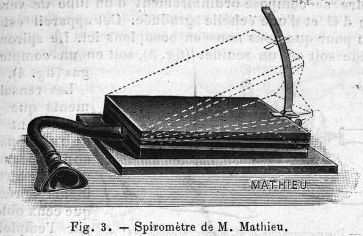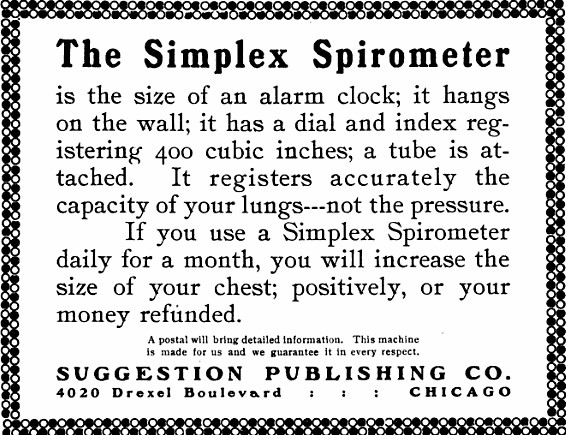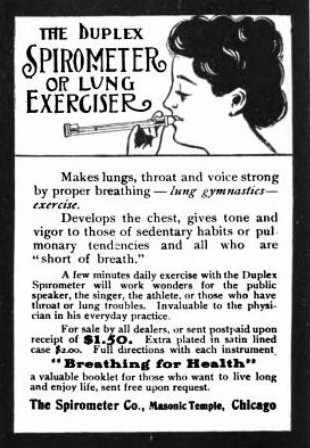
From the International Archives of Laryngology, Otology and Rhinology of, Volume 16, 1903, page 385. Found on the Medic Database.

From the International Archives of Laryngology, Otology and Rhinology of, Volume 16, 1903, page 385. Found on the Medic Database.

Found in Suggestion, Volume 10, 1903, page 177.

Manufactured by the Spirometer Company. Found in Philharmonic: A Magazine Devoted to Music Art Drama, Volume 1, April 1901, page vi.
An early bi-directional flow sensor. From “Bijdrage tot de pharmacodynamica der respiratie.” By Evert van Kekem, Published by the University of Utrecht, 1905.
Two small plastic counterbalanced cups were suspended in a white spirit (alcohol?) bath (essentially small water-seal spirometers). Small tubes (H, H’) lead to each of them from either side of a pitot tube. Airflow through a pitot tube causes one side to rise and the other to fall. Which cup rises and which cup falls depends on the direction of airflow. The motion of the stylus (D) was roughly proportional to the flow rate.
From Johns Scott Haldane and John Gillies Priestley. “The regulation of the lung‐ventilation.” The Journal of physiology 32.3-4 (1905): 225-266.
“In investigating the normal respiratory ventilation is is evidently important to avoid breathing through tubes, vales, etc,. and equally important to have a definitive quantitative record of the air breathed. In order to attain these two objects we employed a body plethysmograph arranged as follows (see Fig. 2).
“The box of the plethysmograph was of such a size and shape as to include as small a space as practicable, and yet enable the subject of the experiment to sit in perfect comfort. Its internal dimensions were as follows:–Floor, 45 inches long. Back, 19-1/2 inches wide x 24-1/4 inches. Lid, 19-1/2 inches wide behind x 16 inches in front x 14-3/4 inches. Sloping front, 37-1/4 inches x 16 inches x 10 inches. End, 10 inches wide by 12-1/2 inches high.”
“The lid was in two parts, with a circular aperature in the middle, through which the neck passed. Thumb-screws were provided for fastening it to the box, and all joints, screw-holes, etc., were made tight with “plasticene” (modelling wax). Air-tight connection was made between the neck of the subject and the lid of the box by means of a rubber collar with a broad flange, which was slipped over the head, and fitted the neck as tightly as possible without causing congestion. The flange was pressed down tightly on a layer of plasticene on the lid of the box by a ring of wood. This wooden ring was of course in two pieces, and was pressed down on the collar by means of thumb screws.
“In the side of the box were two holes into which tubes were fitted by means of corks. One of these was connected with a rubber tube for letting air into or out of the box to adjust the level of the writing-point and counteract, if necessary, the influence of rise of temperature in the box. The other was connected with the recording apparatus by means of rubber tubing 1 inch in diameter.
“The recording apparatus itself was arranged as shown in the figure. The cylincer suspended to the balance beam was of light tin plate. Two sizes were used — of 8 and 12 inches diameter — according to the depth of breathing expected. As the up and down movements of the writing-point traced on the smoked cylinder were proportional to those of the bell-jar.”
Text-book of Human Physiology, Including Histology and Microscopical Anatomy: With Especial Reference to the Practice of Medicine, By Leonard Landois, Published by P. Blakiston’s son & Company, 1904, page 209. Despite being invented by Gad, this type of spirometer has become known as a Krogh spirometer.
From Artificial Respiration in Man, by Prof. E. A. Schafer, The Harvey Lectures, Volume 3, Academic Press, 1909, page 226.
“Hutchinson’s spirometer is defective on one point, viz., that the inner cylinder is not equally balanced at all points of its immersion in the water which is contained in the outer cylinder. This defect was made good by Marcet, by the introduction of a secondary counterpoise. This works from a cam-like projection attached to the pulley over which the cord carrying the main counterpoise passes. This cam is so arranged that the secondary counterpoise exerts more leverage the more the inner cylinder of the spirometer becomes lifted out of the water as air passes into it; and in this manner the increased weight of the cylinder is, more or less exactly, compensated.”
From, The Year Book of General Medicine, Volume 1, Year Book Publishers, 1908, page 90.
“A simple aseptic mouthpiece for the spirometer is described by Thomas A. Storrey. This mouthpiece (A) is made of wood, beveled on one end to fit easily between the lips. The other end is made to fit snugly in the bore of the rubber tubing (B) which leads to the spirometer. These may be made anywhere. The Narragansett Machine Company of Providence, R.I., has furnished me with tips at the rate of $3 per thousand. Each mouthpiece is used but once. It is then thrown away. At one-third of a cent each this is not extravagant. With such tips in use the danger of spreading contagion from mouth-to-mouth in our anthropometric investigations would disappear. (Fig. 9)”
T.G. Brodie developed the recording bellows to measure small changes in volume and were intended to be a more accurate replacement for Marey’s tambour. They were intended for research with small animals and there were four sizes: 30×20 mm with a volume of 7.5 cc; 45 x 30 mm with a volume of 25 cc, 60 x 40 mm with a volume of 67 cc and 120 x 80 cc with a volume of 500 cc.
From Brodie, Thomas Gregor. “On recording variations in volume by air-transmission. A new form of volume-recorder.” The Journal of Physiology 27.6 (1902): 473-487.